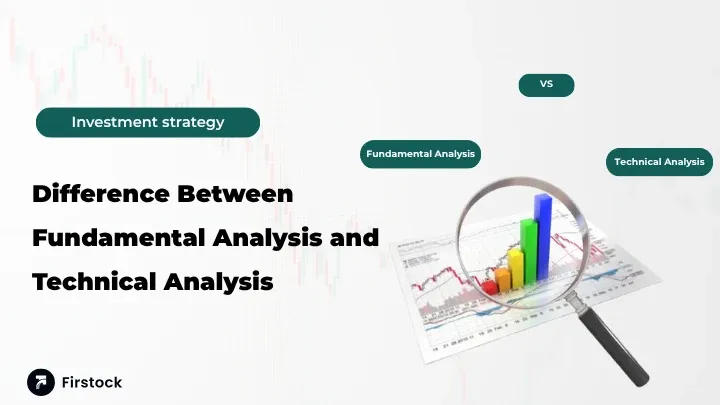Difference Between Fundamental Analysis and Technical Analysis

Fundamental vs Technical Analysis Explained
Investing in the stock market can sometimes feel like entering an unfamiliar dense forest. The area is full of tangled ways, secret traps, and the rare treasures that only a few can find. Their experience is mostly overwhelming, which is exactly what beginners feel.
Through the necessary and essential tools, you are actually holding the secret of the success to your stock market expedition. The two most important tools are fundamental analysis of stocks and technical analysis of stocks.
Many beginners ask, "What is the difference between fundamental analysis and technical analysis?" It is a very important question that knowing both can change the entire investing process dramatically. Thus, in this step-by-step tutorial, readers get deep insights into the distinctions and the features that distinguish them as well as what brings them closer together.
What is Fundamental Analysis?
Let us compare fundamental analysis of stocks to the time you bought a house that is subjected to scrutiny. The inspection comprises the foundation, pipes, and wires. The neighborhood, future developments, and reselling are also tested. By analogy, fundamental analysis literally tells what company's and stock's health is from the inside.
It means to analyze the company’s financial statements and its business model, along with growth expectations. By the way, if there are any pushy or competing companies in the market, they are also taken into account.
The aim is straightforward: find those with lower valuations or the ones that can grow rapidly.
Some of the issues that can be present may be considered in revenue and the earnings of the company: one may wonder how much profit the company makes and whether it is growing with time.
- Profit Margins: What portion of company revenue is made into profit?
- Debt Levels: Whether or not the company can cover its liability without sweating much.
- Industry Position: What is the status of the company relative to the others in the same industry?
- Future Growth Potential: The company may be planning to extend its operations or introduce innovative products only to new markets.
For instance, consider two corporate giants in the tech industry. Company A's revenue has gone up steadily over the years; while having low indebtedness, it also features a popular new product line that has great market potential. In turn, Company B is stuck in aging, loaded with a massive debt structure, and a lack of innovation. So, it is probable that an analyst trained in fundamental techniques will single out Company A as the long-term preferable investment.
Investors who use fundamental analysis of stocks typically adopt a long-term perspective. They look for sustainable growth rather than quick wins, aiming to buy quality stocks and hold them for years.
What is Technical Analysis?
Conversely, technical analysis of stocks can be compared to operating under a weather report for the day. You basically don’t care why the sky poured down; all you want to be informed is about whether to take your umbrella.
Only the previous stock price movements, trading volume, and experience with stocks are what technical analysis deals with. Traders are applying charts, indicators, and patterns for forecasting price changes in the short term.
Some of the most popular tools are:
- Moving Averages (SMA, EMA): Display average prices over a set period to detect trends.
- Relative Strength Index (RSI): Quantifies momentum and probable overbought/oversold conditions.
- Support and Resistance Levels: Are the prices at which stocks tend to change the direction of the movement.
- Candlestick Patterns: Are types of visuals representing potential moves in the market.
The fundamental method compares a company's "well-being" to the technical model, which is a reflection of "market psychology" and price trends. Money-makers use this method to quickly gain profit from market-movement in the short or middle time span.
Difference Between Fundamental Analysis and Technical Analysis
Let’s break down the difference between fundamental analysis and technical analysis side by side:
The fundamental analysis of stocks and technical analysis of stocks differ significantly in terms of what they focus on and how they arrive at their decisions. Fundamental analysis looks into the heart of the company, while technical analysis deals with price action caused by supply and demand forces.
Why Both Analyses Matter
Despite the contradictions in their methodologies, they are not incompatible - in fact, it is said that using both methods is the smartest strategy.
- First fundamental, then technical: Use fundamental analysis of stocks to pick the most robust stocks, and technical analysis of stocks to find the best moments to come in and get out.
- Risk control: Even if the company's fundamentals are solid, technical analysis can help you avoid losses in the short term.
- Complete picture: With both, investors not only get to know if the company is in good shape, but also what the market thinks.
Take, for example, a company with a very bright future. Fundamental analysis would indicate that it is a stock worth buying, but technical analysis is telling that the stock is at a level of resistance. Enhancing your profits waiting at the right exit point.
Real-Life Example: Combining Both Approaches
Let's think that you are interested in investing in clean energy companies.
- Fundamental Analysis: You go through the company's earnings, cash flow, liabilities, and growth strategies. The company has been consistent in revenue growth and is launching innovative products. You find out that it has strong long-term potential.
- Technical Analysis: You analyze the price chart and find a support level at ₹1,200. The price at the moment is ₹1,250. You do not enter the market yet, but rather wait for either a small decline or a confirmation of the upward trend.
By integrating the information from both sorts of analysis, you not only lessen the hazards but also improve your timing for investment.
Benefits of Fundamental Analysis
- Creating Wealth Over Time: Investing in powerful companies you can reap compounding benefits for years to come.
- Minimizes the Risk of Unfavorable Investments: Doing solid, diligent research reduces the probability of ending up with shares of unsteady companies.
- Positive Holdings Under Market Volatility: When you are abreast of the fundamentals, it is easier to weather the storm in the market.
Benefits of Technical Analysis
- Get Right Timing for Your Trades: It helps you pick the most optimum time to buy or sell your shares.
- Chances for Quick Profits: Perfect for traders who are looking to make gains out of the price changes.
- Use of Visual Patterns Simplify Decision-Making: Just by looking at charts and using a couple of indicators you get quick insights, no deep company investigations are needed.
Limitations of Each Method
Fundamental Analysis
- Extensive Time Process: Needs the disclosure, study, and report of the company and the whole industry.
- Not Appropriate for Day Trading: The price of even strong companies can fall in the short term.
Technical Analysis
- Overlooks Company Fundamentals: The stock may be overpriced even if the chart pattern looks bullish.
- Market Unpredictability: Technical patterns rely on probabilities, not certainties.
Tips for Newbies
- Know your investment horizon: Long-term investors need to put emphasis more on fundamentals; a trader who is more technical will rely on market patterns.
- Mix both analyses: Pick up stocks which are fundamentally sound and technically charted for buying/selling.
- Keep abreast of developments: Frequently go through financial statements, market news, and price charts.
- Learn to wait your turn: Both systems require regularity and control.
- Practice on simulated accounts: Particularly for technical analysis of stocks, there is no risk in paper trading skill development.
Concluding Remarks
If you really want to be a successful investor, then you have to understand the difference between fundamental analysis and technical analysis.
Fundamental analysis of stocks serves the purpose of scoping out companies with a sound financial condition and giving them a great chance of expanding in the long run.
Technical analysis of stocks is mainly for traders, who, basing their short-term moves on market tendencies, make informed decisions quickly.
The use of both methods together allows investors to make more confident and strategic investment decisions.
Investing is a decision made partly on intuition and partly on thorough research. Being proficient in fundamental analysis and skilled in reading technical analysis charts will surely put you at an advantage for smooth market navigation. The application of these concepts is not only essential, if you happen to be a beginner who just made the first investment, but also, if you are an experienced trader, constantly perfecting your strategy.
Keep in mind: Success in the stock market follows a pattern of patience, discipline, and knowledge gathering. One that will turn you into a more informed, confident, and better-performing investor is mastering the toolkit of fundamental and technical analysis.
FAQs
1. Which method is better: fundamental or technical analysis?
The decision is hinged on the goal of the investor. Long-term investors derive value from fundamental analysis of stocks while short-term traders rely on the technical analysis of stocks.
2. Is it possible for a beginner to use both techniques?
Rather so! Even simple technical indicators can support long-term investors in timing their trades better.
3. Does technical analysis take into account company profits?
Definitely not. It only considers and focuses on price behavior, volume, and investor psychology.
4. How long should I hold on to stocks selected by fundamental analysis?
On average, 3–5 years or longer if the company keeps growing and the market is favorable.
5. Can we always rely on the technical indicators?
Not really. They signal the likelihood of a pattern or trend, not the absoluteness of it. Proper risk management is therefore critical.





